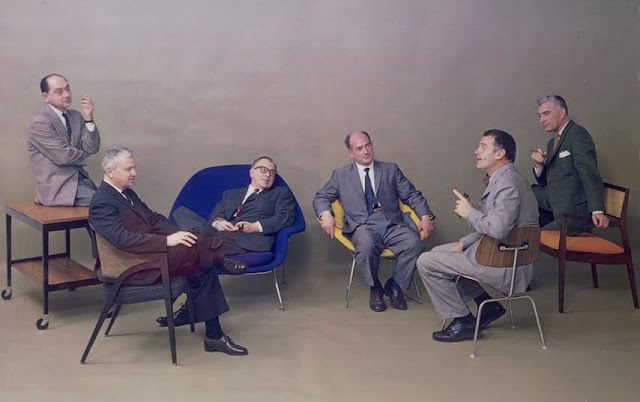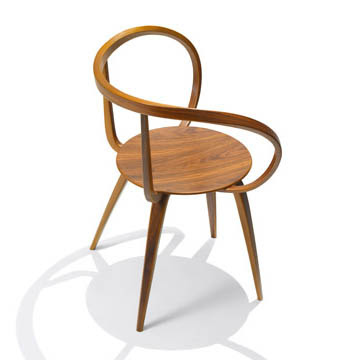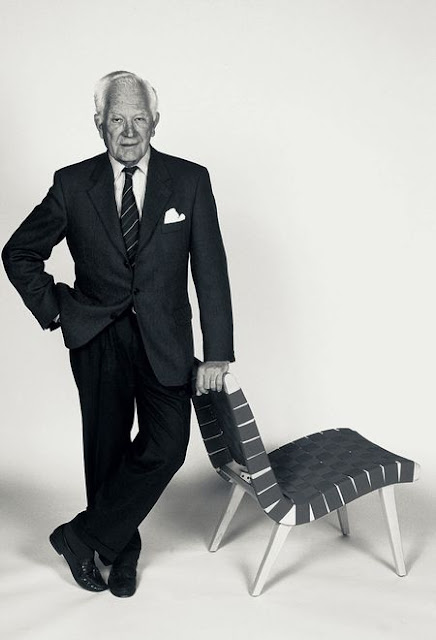From left to right: George Nelson, Edward Wormley, Eero Saarinen, Harry Bertoia, Charles Eames and Jens Risom.
In July of 1961 Playboy did an editorial "Designs for Living" which applauded mid-century designers for "combining functionalism with aesthetic enjoyment." The relaxed photo above is from the same photo shoot but did not run in the magazine, the one below made the cut.
___
“The simple joy of taking an idea into one's own hands and giving it proper form, that's exciting.” _ George Nelson
marshmallow sofa
platform bench
swag chair
pretzel chair
coconut chair
___
Edward J. Wormley (1907-1995) Furniture Designer. In 1931, he was recruited by DUNBAR and quickly became their Director of Design. Wormley's tenure as Design Director spanned over thirty years and is considered one of the most historically meaningful between a designer and manufacturer.
Some of his designs are: The Gondola sofa, Tete-a-tete chaise, Listen to Me chaise and the Rocking chaise.
“Furniture is needed for practical reasons, and because it must be there, it may as well be as pleasant as possible to look at, and in a less definable psychological way, comforting to the spirit.”–
Edward J. Wormley
“Modernism means freedom—freedom to mix, to choose, to change, to embrace the new but to hold fast to what is good.”– Edward J. Wormley
Gondola sofa
Tete-a-tete chaise
Listen to Me chaise
The Rocking chaise
___
Eero Saarinen (1910-1961) Finnish American architect and industrial designer of the 20th century famous for varying his style according to the demands of the project: simple, sweeping, arching structural curves or machine-like rationalism. During his long association with Knoll he designed many important pieces of furniture including the "Grasshopper" lounge chair and ottoman (1946), the "Womb" chair and ottoman (1948), the "Womb" settee (1950), side and arm chairs (1948–1950), and his most famous "Tulip" or "Pedestal" group (1956). Don't miss my previous post on Eero.
"The purpose of architecture is to shelter and enhance man's life on earth and to fulfill his belief in the nobility of his existence"_ Eero Saarinen
"To me, the drawn language is a very revealing language, one can see in a few lines whether a man is really an architect"_ Eero Saarinen
Tulip arm chair
Grasshopper lounge chair
Womb chair and ottoman
___
"The urge for good design is the same as the urge to go on living." _ Harry Bertoia.
Diamond chair
Large Diamond chair
Diamond chair collection
Spray
___
Charles Eames (1907–1978) and Bernice Alexandra "Ray"(1912–1988) were American designers, who worked in and made major contributions to modern architecture and furniture. They also worked in the fields of industrial and graphic design, fine art and film. With a grand sense of adventure, Charles and Ray Eames turned their curiosity and boundless enthusiasm into creations that established them as a truly great husband-and-wife design team. Their unique synergy led to a whole new look in furniture. Lean and modern. Playful and functional. Sleek, sophisticated, and beautifully simple. That was and is the "Eames look": A chair that looked like a potato chip. Another that resembled a "well-used first baseman's mitt." A folding screen that rippled.
"The details are not the details. They make the design."_Charles Eames.
"What works good is better than what looks good, because what works good lasts." _ Ray Eames.
Rocking chair
Chair Low
Lounge chair and ottoman
"warm, receptive look of a well-used
first baseman's mitt."_ Charles Eames.
La chaise
Eiffel chair
–––
Jens Risom (1916) Yes, he is the only one still alive. Danish American furniture designer. An exemplar of Mid-Century modern design, Risom was one of the first designers to introduce Scandinavian design in the United States. With a career that has spanned nearly 70 years, Risom made his mark designing one of the first chairs to be manufactured by Knoll.
"Good design means that anything good will go well with other equally good things." _ Jens Risom.
"I came to this country to study contemporary American design, but when I got here I realized there was no such thing." _ Jens Risom.
Risom collection
Risom desk
Lounge chair
Jens chair
___
The End





































